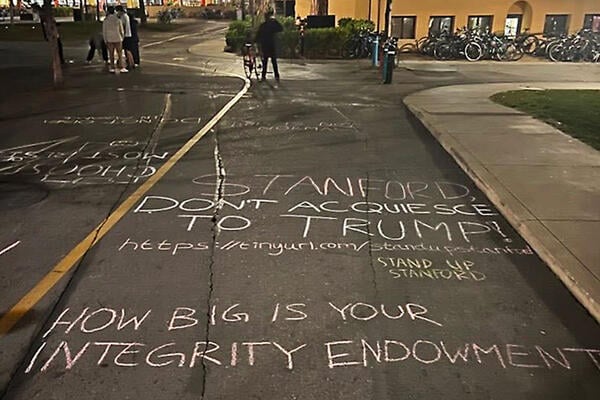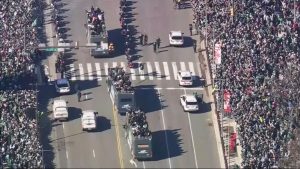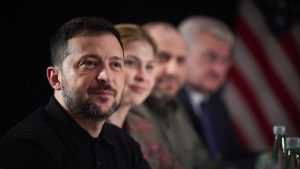As President Donald Trump churned out more than 80 executive orders over the past three weeks, sending the higher education community into a panic, some students were surprised to see a lack of campus protests—even at institutions traditionally rife with activism.
“I haven’t seen a whole lot, which is kind of uncharacteristic of our campus,” said Alana Parker, a student at American University in Washington, D.C. Though she’s heard of certain student political groups protesting on Capitol Hill, things have been quiet on campus.
“I don’t really know why that is, because, in my opinion, there should be more of an outcry. But from my perspective, I think people feel really disenfranchised and like there’s nothing we can do,” she said.
It’s a stark contrast from two semesters ago, when AU was one of dozens of campuses that made national news after pro-Palestinian students set up encampments in opposition to their universities’ investments in companies with ties to Israel.
Students and faculty at AU—and on campuses across the nation—also protested in 2017 after Trump prohibited individuals from seven majority-Muslim nations from entering the United States, according to a news report from the time.
Angus Johnston, a historian of student protest movements and a professor at Hostos Community College, said that he’s not entirely surprised that campuses seem relatively calm. Over the past 20 years, institutions have grown less and less permissive of student protests, culminating in a harsh crackdown on pro-Palestinian protests in spring 2024—in some cases involving police arrests. Since then, many campuses have introduced new—or enforced existing—rules restricting when, where and how students can demonstrate.
Aron Ali-McClory, a national co-chair of the Young Democratic Socialists of America, said that universities’ restrictions on free speech are “100 percent a factor” in why there aren’t many protests happening on campuses right now.
But they noted that the YDSA is mobilizing, just in different ways. Many campus chapters are currently focused on campaigning for their institutions to become “sanctuary campuses,” in the vein of sanctuary cities, municipalities that do not comply with federal immigration laws. Ali-McClory said the chapters involved in that movement are currently distributing petitions, informing their peers about the movement and handing out “know your rights” materials that aim to inform immigrants of how to handle conversations and interactions with immigration officers.
“Looking at what our YDSA chapters are doing across the country, we’re seeing people pivoting to meet the moment on their campus. A lot of that looks less like, ‘Let’s go out and do a protest’ and more, ‘How do we make material gains when the cards are stacked against us?’” they said.
Parker, the AU student, has also chosen to make her voice heard in a different way. An editor of the student newspaper, The Eagle, she and her colleagues penned a staff editorial calling on the university to speak out against Trump’s executive orders, particularly those targeting immigrants and diversity, equity and inclusion efforts. She said the article seemed to be effective: A few days after its publication, the institution sent an email to the campus community, signed by President Jonathan Alger, outlining resources available for immigrant students and employees.
Alger also addressed DEI, writing, “As we continue fostering an inclusive and welcoming community, we are working with teams across campus to determine the impacts on our inclusive excellence strategy and programs.”
‘A Powerful Force’
A handful of campuses have seen protests, primarily in response to their institutions taking steps to comply with Trump’s executive orders by shuttering DEI offices or removing DEI-related language and resources from webpages, for example.
At Missouri State University, students staged a protest after administrators announced they would close the Office of Inclusive Engagement and end other DEI programs “in response to changes nationwide and anticipated actions regarding DEI at the state level.”
According to the student newspaper, The Standard, 50 students gathered outside the main administrative building on Jan. 31 to call for the removal of the university’s president and to advocate for the passage of two bills that would require Missouri schools to teach about Black history and “the dehumanization of marginalized groups.”
At Stanford University, a group of about 15 students participated in a chalking event, writing messages of dissent, like “DEI makes Stanford Stanford,” on bike paths around White Plaza, a central outdoor area on campus.
“Here at Stanford, the important thing to me was that my leaders at my school knew that there would be people who would resist anything that they did to cave to Trump,” said freshman Turner Van Slyke, who organized the demonstration. “I think those leaders just knowing that there’s going to be resistance can be a powerful force for maintaining decency against Trump.”
Various other student news sources have reported that students at their institutions have joined outside groups in protesting at their state capitols, hoping to register their objections to Trump’s orders with governors and state representatives.
Johnston noted that more protests may erupt elsewhere as students begin to see the ways that the executive orders are impacting their campuses more directly.
“There’s a lot of stuff that is happening now that is essentially a hand grenade or a time bomb that’s going to explode in days or weeks or months,” he said. “To a large extent, I think this stuff is not having direct impact on a lot of [students] as of yet. Some stuff may be beginning to percolate down to the campus level. But a lot of this is real stuff that is happening, but the effects of it are not being felt directly by students just yet.”








